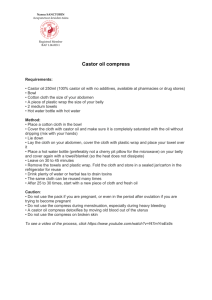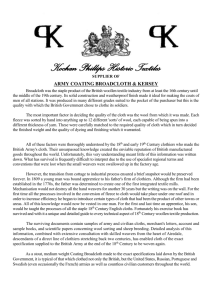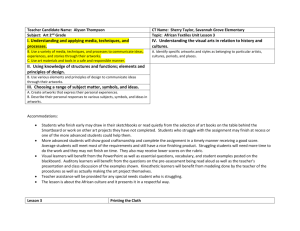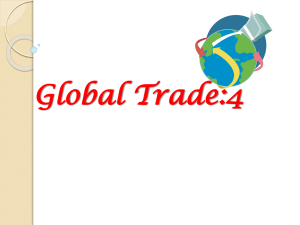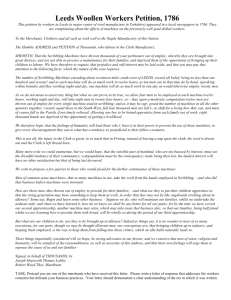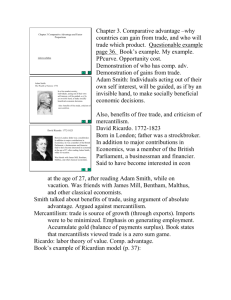Chapter 3
advertisement
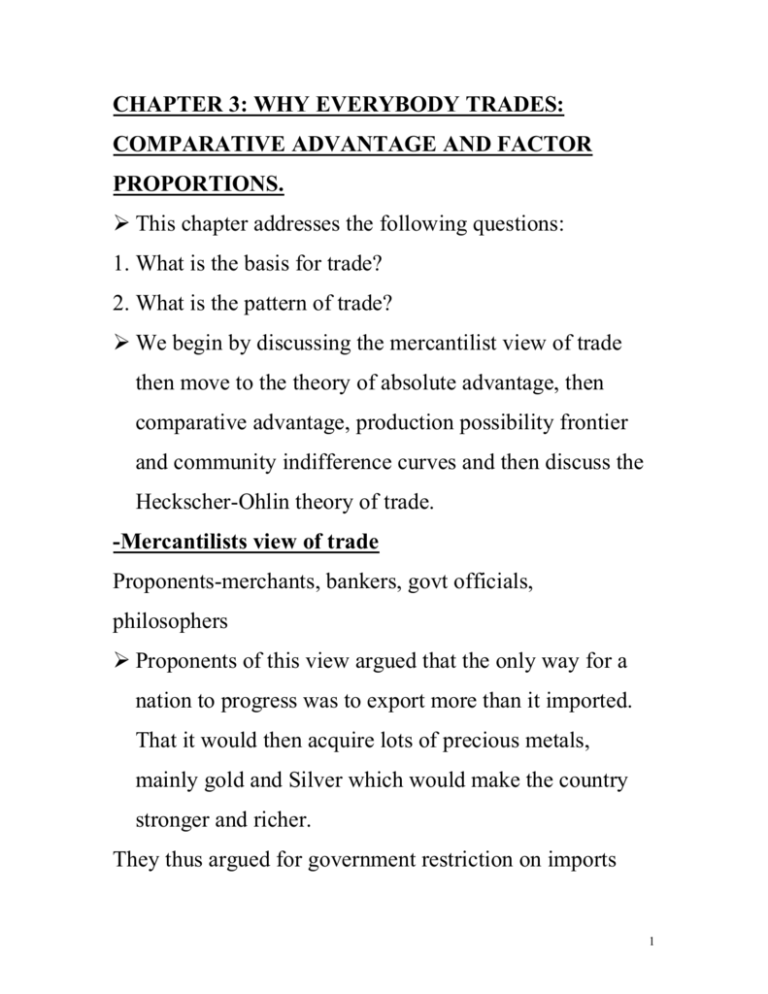
CHAPTER 3: WHY EVERYBODY TRADES: COMPARATIVE ADVANTAGE AND FACTOR PROPORTIONS. This chapter addresses the following questions: 1. What is the basis for trade? 2. What is the pattern of trade? We begin by discussing the mercantilist view of trade then move to the theory of absolute advantage, then comparative advantage, production possibility frontier and community indifference curves and then discuss the Heckscher-Ohlin theory of trade. -Mercantilists view of trade Proponents-merchants, bankers, govt officials, philosophers Proponents of this view argued that the only way for a nation to progress was to export more than it imported. That it would then acquire lots of precious metals, mainly gold and Silver which would make the country stronger and richer. They thus argued for government restriction on imports 1 especially of expensive consumer goods. Mercantilists: Thus there would be benefits to both exporters and import competing industries Thus trade was a zero sum game-One benefits at the expense of the other nation It was further argued that since the amount of Silver and Gold were fixed one nation would gain only at the expense of the other. Wealth was by then measured in terms of stock of precious metals. Acquisition of these enhanced a nation's national power, stronger armies and more expansion of territorial boundaries. Although this has been criticized neo mercantilists argue along the same lines. Argue that exports create employment while imports create employment in foreign countries. Q. Why would countries voluntarily engage in trade if it is not mutually advantageous? -Trade based on absolute advantage. 2 Adam Smith, father of modern economics, argued that for two nations to voluntarily trade with one another, both must gain from trade. Absolute advantage- Occurs when one nation is more efficient in the production of the good. Can produce more with same amount of resources than the other nation. Countries will then trade when one has absolute advantage in one good and not the other. If this happens resources will be utilized more efficiently and output will increase-This results in gains from trade that will accrue to both nations. Consider Canada and Nicaragua. Canada has absolute advantage in Wheat and Nicaragua in Bananas. Thus Canada should specialize in wheat and export surplus to Nicaragua in exchange for Bananas. Adam Smith argued that for laizzez faire unlike the mercantilists who argued for govt. intervention. Thus free trade should lead to resources being used more efficiently and consequently maximize welfare. 3 Exceptions it was argued was the protection of industries that are crucial for a nation's defense. Example on absolute advantage. US Wheat(bushels/ma 6 UK 1 n hr) Cloth(yards/man 4 5 hr) Q. Which country has absolute advantage in production of Wheat? How about Cloth? A.US, U.K. Note that by specializing total world production will increase. Consider for example if each country had 60 hrs and w/o trade allocated have the time on Wheat and cloth to with free trade outputs. Absolute advantage however fails to explain most trade among nations especially among developed nations. Please see also example in textbook p.38. 4 -Comparative advantage. David Ricardo in 1817 argued for this theory in his book-The principles of political economy. US Rest of the world 0.25 1.0 0.5 0.67 Productivity Yard of cloth per labor hr Bushels of Wheat per labor hr In this case rest of the world has absolute disadvantage in production of both goods. Comparative advantage argues that the country should specialize and export the commodity in which its absolute disadvantage is smaller and import the commodity in which it has a higher absolute disadvantage. Consider in aurtaky what the relative prices would be. How much would I yard of cloth cost in terms of wheat? 5 (barter trade). A. 2 bushels of wheat. Note that this is the opportunity cost of a yard of cloth. Opportunity cost defined as the amount of production that you of the other product that you give up=loss/gain or in this case 0.5/0.25: Note that in a two nation, twocommodity case one nation cannot have comparative advantage in both commodities. Calculate opportunity costs for the above table. Is arbitrage possible assuming no transport costs? Buy cloth in ROW at 0.67 bushels and sell it to US at 2 bushels and thus make arbitrage profit of 1.33 bushels per yard of cloth. As more cloth goes to US price of cloth in US declines in US and increases in ROW. International price with free trade will settle somewhere between the two opportunity costs. Ricardos analysis is based on the concept of opportunity cost Specialization and trade can then be explained in terms of opportunity costs. 6 Another Example: Production for given level of resources e.g. one hour: US UK Wheat 3 1 Cloth 2 2 What is the opportunity cost of Wheat in US? How about Cloth? How about the UK? Who has Comparative advantage in Wheat production? Cloth? Therefore based on opportunity cost the US should specialize in Wheat production and the UK in cloth production Basically a country specializes in the good in which it has the least absolute disadvantage (or in which it has the greatest relative advantage). - We can show gains from Trade using PPC and assuming constant costs. In this case the PPC will be linear. The PPC shows combinations of outputs of different goods that an economy can produce given its resources. 7 - The straight line indicates that a constant opportunity cost. The slope indicates the relative price of the good on the horizontal axis. See Fig 3.1. Thus trade will result in an equilibrium international price ratio that is in between the two-non trade price ratios. Each country will specialize in the good that it has comparative advantage. Each cou8ntry is able to consume outside its PPF. - US has 100 hrs and productivity is 0.5 bushels of wheat per hr and 0.25 yards of cloth per hr. The rest of the world also has 100 hrs with productivity of 1 yard of cloth and 0.4 bushes per labor hr. US specializes in Wheat and Rest of the world in trade. Before trade in the US is 2 bushels per yard. In the rest of the world it will be 0.67 bushels per yard. Without trade each country has to consume on or below the PPC. With Free trade price of a yard of cloth will settle between the two-pre trade. Assume trade price is 1. And they exchange 20 bushels for 20 yards. Who gains who benefits? US: In exchange for 20 bushels what is the minimum 8 amount of cloth US is willing to accept. 2 bushels= 1 cloth. Therefore Us was willing to accept 10C. It gains 10C Rest of World: For 20 bushels what is the maximum cloth they would have been willing to give up? Willing to give up upto 1.5 yards per bushel. Therefore 30 yards. So they also gain 10C Note that with trade they are able to consume outside the PPC. Note that Rircardo assume constant marginal costs. Assumption of homogenous factors of production. We have so far we assumed that the PPF were linearconstant opportunity costs which assumes that inputs are homogenous an are used in fixed proportions. We consider the case of increasing opportunity costs. In figure 3.2 shows increasing opportunity cost of Cloth as we move left to right. Note that as move from right to left they're increasing costs of wheat production. 9 Production possibility frontiers that reflect increasing opportunity costs are concave. .Why? -Resources are not homogenous -Resources are not used in fixed proportions. As we produce more of that good a nation utilizes resources that are less efficient in production of that commodity. What point on the PPC is actually chosen. In free markets the market price ratio will determine which production point is chosen. Production will be driven to levels at which the opportunity cost of producing another unit just equals the price at which output can be sold. This reflects tangency between the PPC and the price line. Consider when price of cloth interms of wheat is 2 bushels per yard. If the opportunity cost of producing another yard of cloth is less than 2 bushels then produce more cloth and sell it for wheat. If opportunity cost is more than then make less cloth and more wheat. If it equals 2 then there is no incentive to produce more cloth or less. 10 . Community indifference. We move from production to demand side We can show tastes or demand preferences by use of community indifference curves. These are analogous to individual indifference curves and we assume they satisfy same axioms as in individual indifference curves. See figure 3.3. Convex and downward sloping indicating that to consume more of good a nation has to give up some of the other. We define marginal rate of substitution as the amount of Y that a nation could give up for one extra unit of X and still remain on the same indifference curve. This is given as the absolute slope of community indifference curve and declines as we move left to right. The actual point where the consumer ends will depend on the budget constraint that the consumer faces. The slope of the budget contraint will be given by Pc/Pw. In figure 3.3 consumer maximizes utility by choosing 11 point D. We will apply the same technique to analyzing a nation by assuming that the ICs provide information on national well being and budget line represents national budget. Without trade a nation will be in equilibrium when it reaches highest indifference given its PPC This is at point S0. How about S1. Cloths are cheaper, higher DD for cloth thus move down to S1. When trade is opened in the two countries equilibrium international price ratio is established that clears international markets for the two goods. Production in each country shits to the tangency with the new price line. Each country trades along the price to the point determined by tangency of the price line and the new community Indifferrence curve. Pre trade price of Cloth in US: 2 bushels of wheat per yard Pre trade in the ROW 0.67 bushels per yard. Both at S0. The international price will be between 0.67 bushels and 1 bushel. Free trade occurs at rate of 1 bushel 12 per yard of cloth. Both end up at S1 US exporting wheat for Cloth. Exports of cloth by ROW equals imports by US. Both consume at C1 which is on a higher Community indifference curves The right angle between production point and consumption point is a trade triangle showing imports and exports for each country. Note that at any other price of cloth say below 1 imports will exceed exports. Note that the distribution of gains from trade depends on where the international price ends up. Suppose exchange was 2 bushes per yard of cloth who gains? Looses if any between US and ROW. Country gains if price of exports is higher than that of imports. The ration of the two is referred to as terms of trade. Effects on consumption and production -Production increases for the good in which the country has comparative advantage Import competing industry reduces production due to imports 13




